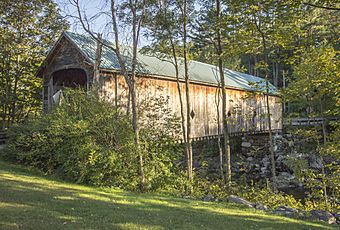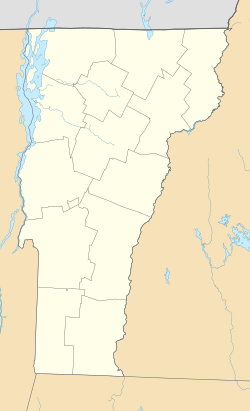Hall Covered Bridge facts for kids
Quick facts for kids |
|
|
Hall Covered Bridge
|
|
 |
|
| Location | Hall Bridge Road, Rockingham, Vermont |
|---|---|
| Area | 1 acre (0.40 ha) |
| Built | 1982 |
| Built by | Granger, Sanford |
| Architectural style | Town lattice truss |
| NRHP reference No. | 73000204 |
| Added to NRHP | August 28, 1973 |
The Hall Covered Bridge is a special bridge located in southern Rockingham, Vermont. It carries Hall Bridge Road over the Saxtons River. This bridge is a replica, meaning it's a copy of an older bridge that was built around 1867. The original bridge was sadly destroyed in 1980. Even though it's a newer bridge, the Hall Covered Bridge was listed on the National Register of Historic Places in 1973.
Contents
What is the Hall Covered Bridge?
The Hall Covered Bridge is found in a quiet, countryside part of southern Rockingham. It crosses the Saxtons River about 1.2 miles (1.9 km) east of the village of Saxtons River.
Bridge Design and Look
This bridge is a single-span bridge. It uses a special design called a "lattice truss." This design was invented by an architect named Ithiel Town. The bridge rests on strong stone supports on both sides of the river.
The sides of the bridge are covered with vertical wooden boards. You'll notice three diamond-shaped windows on the sides. The bridge has a pointed roof made of metal.
The History of the Hall Bridge
The very first Hall Covered Bridge was built in 1867. A skilled local builder named Sanford Granger constructed it.
Original Bridge and Its Importance
When the original bridge was added to the National Register of Historic Places in 1973, it was one of only three covered bridges from the 1800s still standing in Rockingham. Records show there used to be 17 such bridges in the town.
Why a New Bridge Was Built
In 1980, the original Hall Covered Bridge was destroyed. This happened when a truck that was too heavy tried to cross it.
A new, exact copy of the bridge was built in 1982. A builder named Milton S. Graton constructed this replica. He was very careful to make it look just like the old one. He even used oxen (large cattle) to help move the finished bridge into place!



